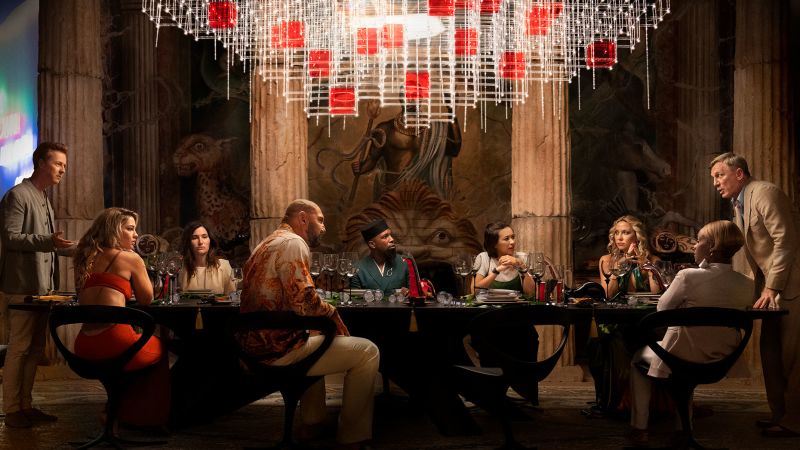Gounod’s opera, with a libretto by Jules Barbier and Michel Carré, draws its story and a share of familiar lines from Shakespeare’s play, making only a few adjustments — Juliette, for instance, awakens before Roméo dies, creating an opportunity for one last love duet, “Salut! tombeau sombre et silencieux!”
Godwin’s vision of “Romeo and Juliet” — for which he’s opted to adopt the English spelling of the title as well as the characters — hungrily samples from a vast cultural cache of vibes associated with the star-crossed lovers. The result is something that feels split between the opera’s 1867 Paris premiere and the everything-all-at-once pop pastiche of today.
This variety of spirit is most immediately evident in Loren Shaw’s costumes, which deliver a dreamlike blur of uncannily compatible anachronism — part masquerade ball, part circus; part “Moulin Rouge,” part “West Side Story”; part Versailles, part Studio 54. The simple, sturdy bridges and arches of set designer Daniel Soule’s Verona felt like a stone hearth for Shaw’s fiery palette of turquoise, fuchsia and glimmering gold. Soule’s ingeniously reconfigurable set also made for quick and impactful scene changes.
Honorable mention goes to projection designer Blake Manns for visuals that added dimensions of scenic depth and psychic dread – i.e. “the veil of night.” Immediately following R&J’s hurried nuptials, we were dismissed to intermission by a sinister apparition emerging from a wall of black smoke. Honeymoon: over.
Despite its indulgent mix of sensibilities, Godwin’s staging is lucid and fluid, mostly in service to the two lovers, but also mindful of the pitfalls of telling a story everybody already knows. Transitions between scenes were elegantly executed, beguiling outbursts of choreography by Jonathan Goddard animated the more populous stretches, and Gounod’s score was given plenty of space to speak for itself.
On that note, it was a terrific night for the Kennedy Center Opera House orchestra and conductor Evan Rogister, who made something of a furnace out of the orchestra pit. In the first act, the strings beautifully modeled the cat-and-mouse feinting of the lovers’ first encounter; in the fifth, they perfectly channeled the rough grain of grief. They sounded downright heavenly in the instrumental preludes to the acts (consolidated for this production into two parts).
It was also a stellar night for the Washington National Opera Chorus, led by chorus master Steven Gathman. They made a strong first impression with the prologue (“Verone vit jadis deux familles rivales”) and surfaced beautifully throughout – especially after the slaying of Tybalt (“Ah! jour de deuil et d’horreur”). Elsewhere, they were vaporous – a musical manifestation of the mist, fog and smoke that Godwin deployed throughout.
But the main attraction here is the singing, delivered by a smartly cast ensemble that seemed precision picked to highlight the natural tonal chemistry of soprano Rosa Feola’s Juliet and tenor Adam Smith’s Romeo. (On Nov. 17, singers from the Cafritz Young Artists Program will sing the lead roles.)
With her signature celebratory waltz (“Je veux vivre”) Feola crafted a Juliet with more than a splash of Carmen to her. She’s defiant and silly in her shimmering bluebird costume, tempestuous as she plucks apart a bouquet of flowers in frustration; and Feola is a strong enough actress to let us observe Juliet’s transformation as the dream of youth gives way to a rude awakening.
Smith’s Romeo, meanwhile, is a heavy pour of passions. His tenor is beautifully suited to Gounod’s arguably Romeo-centric take on the tale — possessing enough authority to anchor the opera, and enough fragility that you fear the whole thing might snap in half. Disbelief didn’t stand a chance against their duets, which often strayed into the magical, especially the long goodbye of “O nuit divine je t’implore” and the final farewell of “Salut! tombeau sombre et silencieux!”
Tenor Duke Kim made a razor sharp Tybalt (the good kind of sharp) and baritone Justin Austin, who gives his Marian Anderson Vocal Award recital on Dec. 12, offered a fiery Mercutio. But I was most taken by bass Nicolas Testé, whose magnificent Frère Laurent made a potentially dull wedding quite captivating (doubly so his one-note description of Juliet’s deceptive poison), and who did impressive double-duty as the Duke of Verona. Bass-baritone Donovan Singletary made a similarly striking Count Capulet, though sounded slightly constricted through the evening, struggling to surmount the orchestra’s swell.
It was also an evening of strong mezzos: Jill Grove’s Gertrude was endearingly cranky, beautifully voiced and a crucial source of comic relief. (Her anticlimactic toss of wedding confetti felt fraught with subtext, as though this were the billionth time she’s tried and failed to assist these doomed kids with their dumb scheme.) And mezzo soprano Winona Martin was delightfully churlish in the trouser role of page, pickpocket and part-time vandal Stéphano, offering a lively “Que-fais tu, blanche tourterelle?” with stunning nimbleness.
It’s a production high on spectacle and yet somehow low on frills. After all, not every boundary needs to be pushed off the edge of the stage; and not every tragedy has to be taken so seriously. There’s a throughline of dark humor, of doomed foresight, and thus, of defiant love in seeing the whole thing through anyway. (Additionally, I never quite realized just how much shade is thrown at poor, unseen Rosaline)
“Romeo and Juliet” is also a production that finds the WNO leaning into its strengths: Strong singing, engaging staging and respect for what brings us to the opera in the first place. Who needs bells and whistles when you have the song of the lark?
“Romeo and Juliet” at the Washington National Opera continues through Nov. 18. Tickets at www.kennedy-center.org



